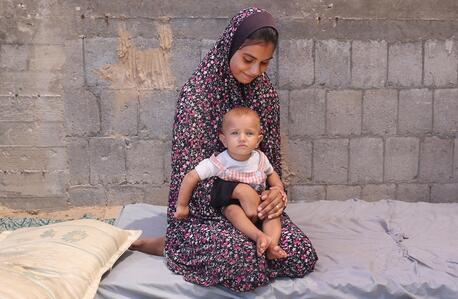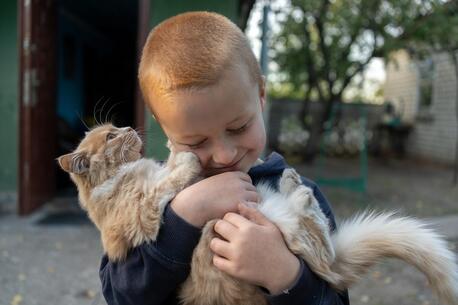
War in Ukraine Highlights Danger Explosive Weapons Pose to Children
UNICEF is increasing explosive ordnance risk education and victim assistance, while advocating for the global eradication of indiscriminate weapons.
UNICEF was founded on the principle that all children deserve to survive and thrive in an environment free from conflict. Conflict can have many harmful effects on children, but explosive weapons pose one of the greatest threats.
Ukraine was already among the most mine-contaminated regions in the world, endangering children who live, play and go to and from school in areas littered with landmines, unexploded ordnance and other explosive remnants of war (ERW). Since the war began, ERW have caused hundreds of civilian casualties and damaged homes, hospitals and schools, while also delaying and restricting critical humanitarian aid.
Over half of all civilians killed by landmines and explosive remnants of war are children
Landmines and cluster munitions are particularly dangerous given their indiscriminate nature and pernicious presence long after conflicts have ended. Antipersonnel landmines are victim-activated and cannot distinguish between the footstep of a combatant or a child. Cluster bombs are among the most harmful weapons to civilians because in addition to their immediate effects, they often remain unexploded, sometimes for decades, retaining their ability to kill or maim for years after a conflict ends.
Explosives also destroy vital infrastructure — like water pipelines, sanitation facilities, hospitals and schools — cutting off children from essential services. The use of both antipersonnel landmines and cluster munitions are banned under international humanitarian law, yet they are still being used in conflicts today, particularly in Ukraine.
Explosive weapons in populated areas and explosive remnants of war are real and present dangers for children in Ukraine. — UNICEF Executive Director Catherine Russell
In Afghanistan, almost 90 percent of child casualties are a result of ERW. Syria is also among the world’s worst countries for the number of landmines planted in unknown locations; mines have killed 699 children since 2011. Over 270 million cluster bombs were dropped on Laos during the Vietnam War; up to 80 million did not detonate, and are still causing child casualties today.
In response, UNICEF calls on all governments to support explosive ordnance risk education, clearance, stockpile destruction, victim assistance and all other measures that will protect children and their communities from the threat of indiscriminate weapons.
Children are especially vulnerable to explosive remnants of war. Unable to identify explosive remnants, they are too often tempted to play with these items or use them to collect a small income, which places them and their families at great risk. — Alice Akunga, UNICEF Acting Representative in Afghanistan
UNICEF USA sits on the Steering Committee of the U.S. Campaign to Ban Landmines - U.S. Cluster Munition Coalition (USCBL-USCMC), a group of non-governmental organizations working to ensure that the U.S. comprehensively prohibits antipersonnel mines and joins the 1997 Mine Ban Treaty. The coalition calls for sustained U.S. government financial support for mine clearance and victim assistance.
UNICEF USA supported a recent Congressional letter urging President Biden to “take all the necessary steps to join the Convention on Cluster Munitions, which bans the use, transfer, stockpiling and production of cluster munitions.” In the meantime, UNICEF has increased its Explosive Ordnance Risk Education (EORE) response and victim assistance programs.
Through various activities, such as needs assessment, development of communication materials, capacity building and implementation of community and school-based activities, UNICEF and partners provide children, families and communities with EORE. For Ukraine, UNICEF created a Facebook series on EORE; as of May 2022, the series has reached 3,479,378 users. A new EORE campaign focused on edutainment videos for children has reached 6.5 million unique users on YouTube. In March 2022 alone, UNICEF reached 24,563 children in Afghanistan with EORE.
It is critical that child survivors who endure staggering physical injury and psychological trauma receive psychosocial support. UNICEF works around the world to strengthen the resilience of children and their families, and to help them cope with adversity during and after a crisis.
No matter where or when they are used, explosive weapons endanger a child's most fundamental rights. UNICEF won’t stop until every child is protected.
TOP PHOTO: Artem, from the city of Kharkiv in northeastern Ukraine, stands on the steps of the underground car park where families have been living, sheltering from air attacks and shelling above. "I hope the war will end, so everything will be all right and peace will come," says the 9-year-old. © UNICEF/UN0642205/Filippov
HOW TO HELP
There are many ways to make a difference
War, famine, poverty, natural disasters — threats to the world's children keep coming. But UNICEF won't stop working to keep children healthy and safe.
UNICEF works in over 190 countries and territories — more places than any other children's organization. UNICEF has the world's largest humanitarian warehouse and, when disaster strikes, can get supplies almost anywhere within 72 hours. Constantly innovating, always advocating for a better world for children, UNICEF works to ensure that every child can grow up healthy, educated, protected and respected.
Would you like to help give all children the opportunity to reach their full potential? There are many ways to get involved.





